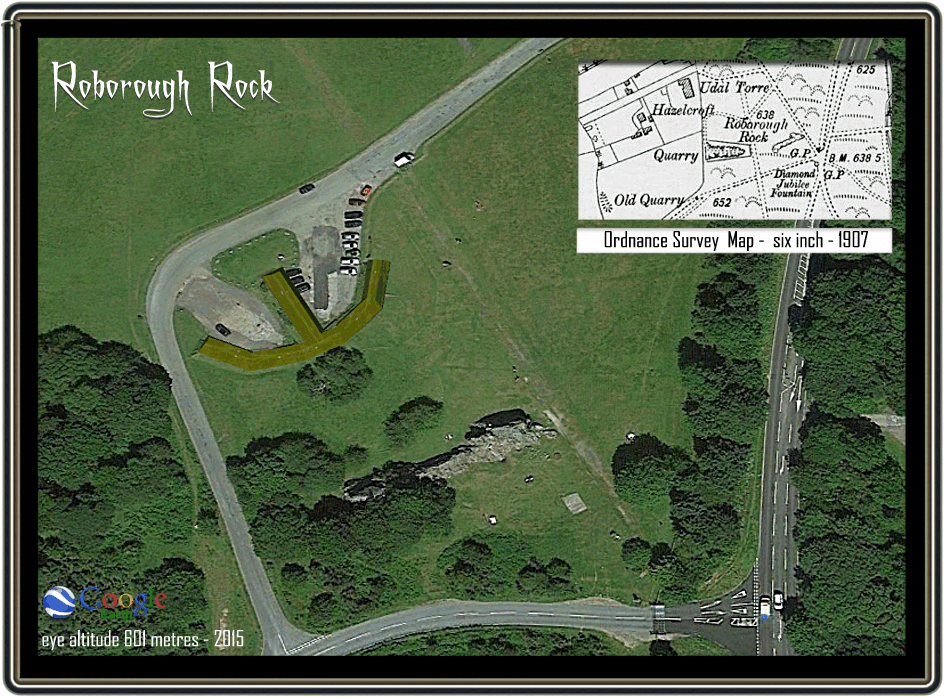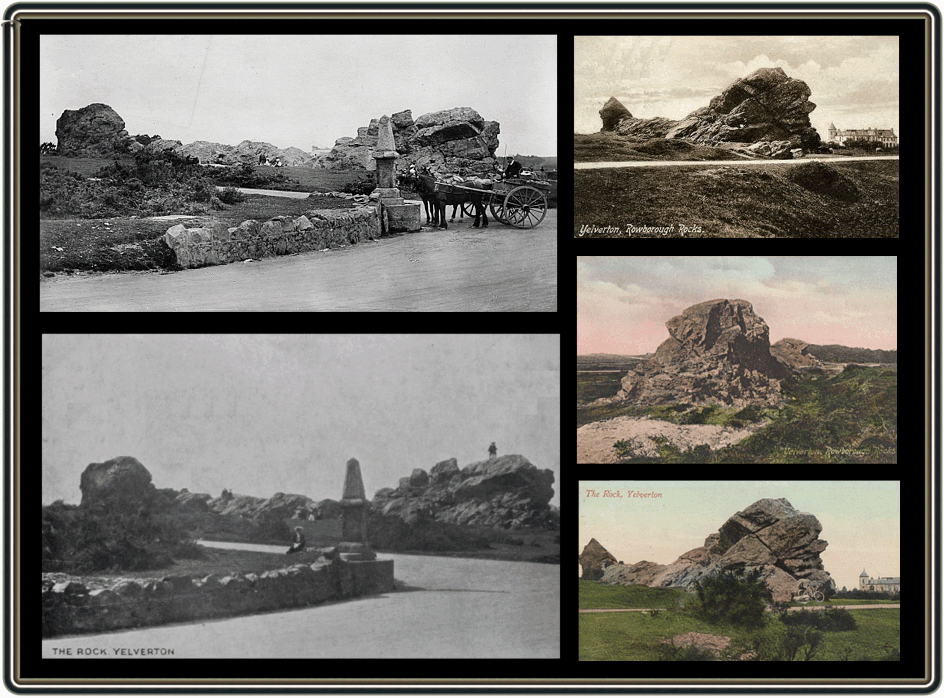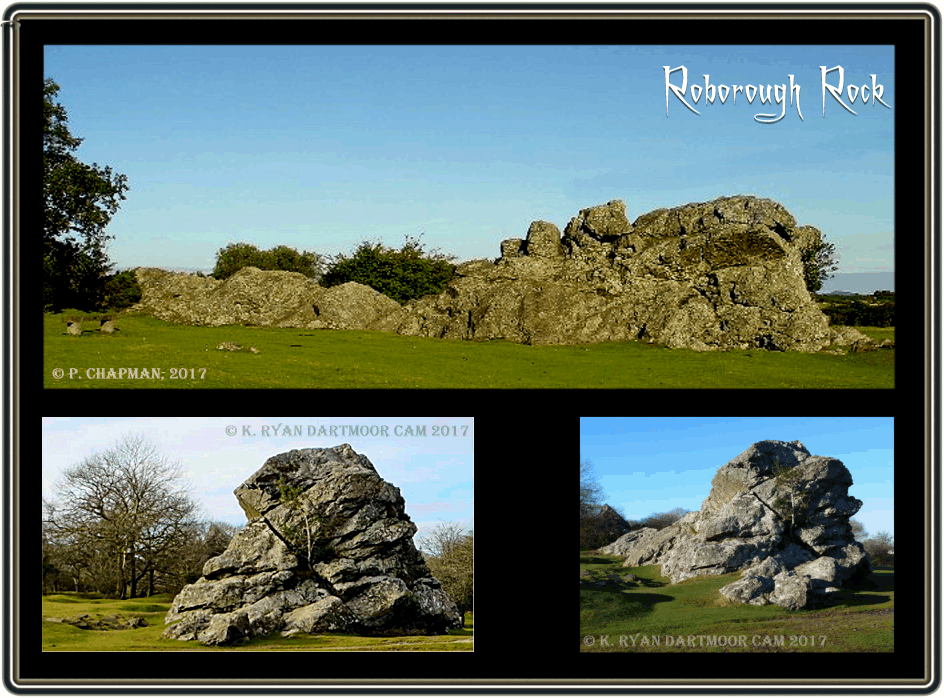
I now observe a massive block,
Well known by name as Roborough Rock,
Which has stood on this English ground,
Yes, ever since the world was drowned:
As autumn leaves we fade away,
But still that rock will keep its stay
Quite firm against all storm and cold,
As was the case in times of old.
George Hamlyn – 1869.
Indeed Roborough Rock can be described as a ‘massive block’ which erupts from Roborough Down.
“On the slope between the eight and ninth milestones is Roborough Rock. It is shown on an eighteenth century map of Devon as Ullestor Rock but early in the nineteenth century was scarcely ever called that name. It consists of two bosses, with a connecting portion of some length and of much less elevation, the whole forming one mass. Crossing, p.444. If you want a more geological description of the rock then according to the Devon County Council’s ‘Educational Register of Geological Sites’ then it’s: “A remarkable tor-like feature representing part of a dyke-like
microgranite intrusion. Country rock is mapped as Upper Devonian, Kate Brook Formation, within the metamorphic aureole of the Dartmoor granite.” If you look at the six-inch Ordnance Survey maps of the early 1900s it is clear that the whole of Roborough Down was once subjected to a great deal of quarrying. The reason for this being that ‘Roborough Stone’ is what has been described as consisting of fine-grained elvan material or more technically – quartz porphyry. The main feature of this stone was that it contained very little sparkling mica which made it ideal for carving and can be seen in several local churches. Perkins, p.116. Other uses the stone was put to was as domestic utensils such as mortars and troughs and in some cases high status tombs. It is for the very reason of the quarrying activities that the “connecting portion of some length and of much less elevation,” that Crossing refers to as it is said to be the result of stone extraction.
The other claim to fame that Roborough Rock can boast is that of having been called over time by a whole collection of different names, some of them begging the question is it a ‘rock’ or a ‘tor’? William Crossing noted that “On the northern side of the eastern boss a rude resemblance to the human face in profile may be traced when seen from the road. In my early days this was always called the ‘Duke of Wellington’s Nose.” Crossing, p.444. Due to this resemblance some folk must have decided the profile was more befitting to that of King George III and so it also became known as ‘George III’s Nose‘. Slipping back further in time to the eighteenth century a early map of Devon showed that the rock had become a tor, namely Ullestor, Crossing, p.44. Then followed a period of confusion as the six-inch Ordnance Survey maps of the early 1900s depict both a ‘Roborough Rock’ and a ‘Udal Tor’ as two separate entities as can be seen on the map etract which accompanies the aerial photograph further down this page. During the same century Benjamin Donn’s map records the rock as ‘Hurstone Rock‘ as can be seen from the extract below: Just to add a couple more names to the mix you also have simply ‘The Rock‘ along with ‘Yelverton Rock‘.
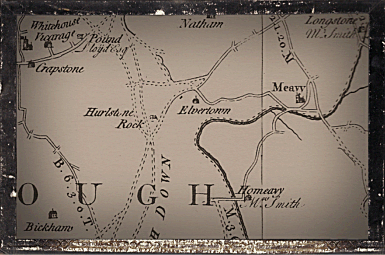
Roborough Rock Miscellany.
At one time Roborough Down was used for military manoeuvres of various sorts which included mock battles, camps etc, when these were being held Roborough Rock was a favourite spot for the public to watch the proceedings.
Being such a prominent feature Roborough Rock was often a venue for various events especially as it provided an excellent viewing platform. In the February of 1889; “A prize fight between Alfred Wright, the ‘champion light-weight of the West’ and Dick Tippett, both of Plymouth, took place on Thursday afternoon near the Roborough Rock. There was a select attendance of about thirty persons, who had paid half a guinea each in order to be present. Wright had the best of the fight, though both combatants were punished severely. Tippett’s hands failing him he could not come up at the call of time, and Wright was declared the winner. The combatants and their friends left the ring in a waggonette.” The Totnes Times, February 9th, 1889.
During the late 1800s and early 1900s the Western Cycling Club Association held a church parade which began at the rock, a newspaper report of 1898 demonstrates what a popular event this was; “In brilliant weather yesterday afternoon an excellent mixed cyclists’ church parade was held under the auspices of the Western Cycling Club Association at the Roborough Rock. The genial sun induced hundreds of cyclists to take part in the proceedings and the Rock presented a very pretty sight surmounted by scores upon scores of the younger element, with a huge throng of cyclists and their machines, pedestrians, and vehicles of all descriptions at the foot. It was roughly estimated that there were between three and four thousand people present at the service, out of which about 600 were cyclists.” The Totnes Times, June 20th, 1898..
In R. N. Worth’s book – ‘A history of Devonshire,’ he too confirms the ‘George III’s Nose‘ theory as well as relating an old folklore story attached to Roborough Rock; “Roborough Rock, near Plymouth – a craggy mass which from one point presents a singularly exact profile of George III.. This rock turns round whenever it hears the cock crow; and if report speaks true, the performance has been eagerly watched for by credulous rustics.” p. 78.
According to Eliza Bray three men were working late on Saturday evening when they saw a huge ball of fire fly out from Roborough Rock. Slowly it edged towards them accompanied by a rumbling sound, as it crept ever closer the flames took on various shapes such as a human figure and a church with arched windows. The apparition lasted well into the early hours of the following Sunday and the petrified workmen became convinced they had been chased by the Devil himself. p.260.
“The scene how changed! – I leave the sunny vale, – Its foliage, flowers, and songs, and tread the heath, – And breathe the breeze of Roborough.” So go a few lines written by N. T. Carrington in his famous work called ‘Dartmoor – a Descriptive Poem’. This poem was later re-published by his son and W. Burt added various notes explaining some of the original lines. With regards to the above lines he noted; “The appearance of this rock, as the passenger travels from Plymouth to Tavistock or Dartmoor, is exceedingly impressive, particularly when it is half veiled by the shadows of evening; and although no such fact is recorded, it may be considered as likely, in superstitious times, to have been applied to some religious worship.” p. 142.
Over time Roborough Rock must have been a silent witness to many memorable events, some of which were of a tragic nature such as this one reported back in 1847. “On Friday morning, the 12th inst., the body of Mr. Henry Rigby, commercial traveller, was found in a pit on Roborough Down. Deceased was in the employ of Mr. Wingrave, straw plait manufacturer of Plymouth. About noon on the Thursday he parted from his employer, who proceeded to Callington, leaving Mr. Rigby at Tavistock to complete their business, and return to Plymouth in the evening. As the day closed it came on to blow strongly from the south-west, accompanied by continual rain. Mr Rigby’s gig was at the Queen’s Head, and he had the horse harnessed at half past six, but, in consequence of the darkness of the night and the severity of the storm, he waited a change of weather, or the chance of another traveller going the same road. Failing in both these expectations, with some foreboding expressions, he left Tavistock, at a quarter past seven. On arriving at the Magpie, at Bedford Bridge he had some refreshment and partook of more at the Roborough Inn, about ten miles form Plymouth. He appears to have continued in the turnpike road over the Down, until he arrived about a gun-shot distance from the Roborough Rock, on the Plymouth side where the horse would be exposed to the full force of the storm. Here the wheel ruts of his gig were traced in a zig-zag returning direction over the down, until they reached a pit to the south of the Roborough Rock, in which Mr. Rigby’s body was discovered, with several severe contusions on the face and head. The gig, which is a heavy four-wheeled vehicle and contained a quantity of goods, was turned upside down, and rested on the body of the deceased, who lay on his back, with his whip firmly grasped in the hand. One of the shafts was broken and the horse, which was unhurt and partly disengaged from the harness, was quietly standing by the dead body of his master. It is conjectured that on the first occurrence of the accident the animal, in endeavouring to disentangle himself, may have tramples on and crushed Mr. Rigby’s face and head. The only suspicious circumstance is, the fact of but 1s. 11d. being found on his person, when it is known that he received some small amount from tradesmen in Tavistock after the departure of Mr. Wingate. The pit in which the melancholy circumstance occurred, is one of a great number, formed probably by surface ancient mining operations on the Down. It is about ten feet deep, and of moderate area. Before the accident, the wheels of the gig passed withing a few inches of another pit, especially dangerous…” – The Evening Mail, November 17th, 1847.

Bray, E. 1836. A Description of the Part of Devonshire Bordering on the Tamar and Tavy. London: John Murray.
Carrington, H. E. 1826. Dartmoor – A Descriptive Poem. London: John Murray.
Crossing, W. 1990. Crossing’s Guide to Dartmoor. Newton Abbot: Peninsula Press.
Perkins, J. W. 1984. Geology Explained: Dartmoor and the Tamar Valley. Newton Abbot: David & Charles.
Worth, R. N. 1895. A history of Devonshire. London: Elliot Stock.
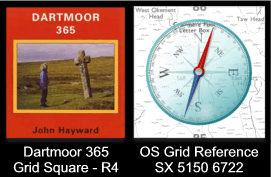
“”The Rock” is a popular playground. It stands back from the main road and is largely screened from traffic.” John Hayward, Dartmoor 365, p.311.
 Legendary Dartmoor The many aspects past and present of Dartmoor
Legendary Dartmoor The many aspects past and present of Dartmoor

